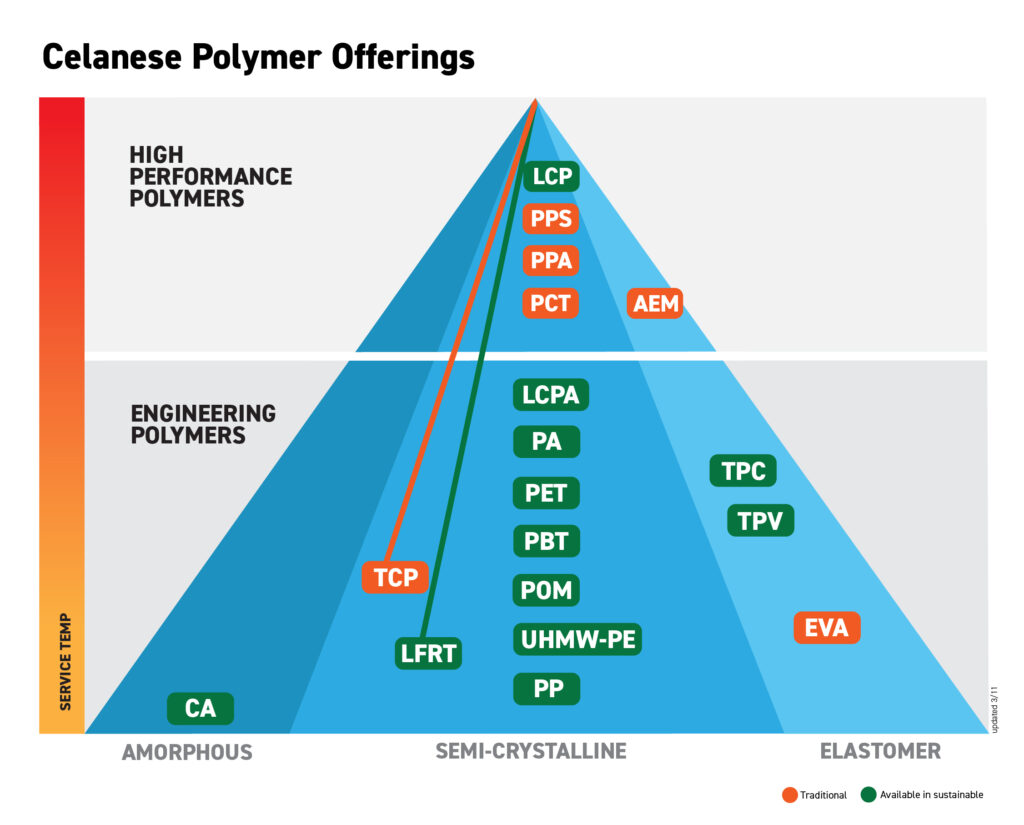
Celanese has the largest portfolio of engineering thermoplastics.
For a hundred years or so, after the internal combustion engine replaced electric propulsion, the industry focused on fine-tuning what was essentially the same basic technology.
All OEMs made cars powered by pistons, using pretty much the same materials to the same quality standards.
Now the electric car is back, and all that has changed. Battery technology is evolving in any number of different directions. Chemical and component suppliers need to be agile and adaptable in a world where there is no certainty.
Automotive Industries spoke to Tobias Beckenbauer – Marketing Manager, EV battery development and Klaus Bender – Leader of the application development team for automotive electrification at Celanese at the Battery Show Europe 2024.
AI: What is your core business?
Bender: With the acquisition of the DuPont engineering polymers business in 2022, and the Santoprene TPV business the year before, Celanese has the broadest product portfolios of engineering polymers worldwide.
But, we don’t see ourselves as a product supplier only. We focus on solutions and how we can add value by helping customers design parts.

While it is clear we make our money from selling materials, we back our products up by providing solutions.
We have expert teams that cover specific segments like battery components, power electronics, and thermal management.
The responsibility of these teams is to create a value proposition for the customers through the selection of the right material from our broad portfolio to provide a sustainable solution.
Because we know it’s not a short time game, we want to make sure that whatever we do with all the efforts we put into this is sustainable.
Our application development teams have developed expert knowledge for electric vehicle applications so we can speak the language of our customers, understand their challenges and concerns, and collaborate on solutions. We also have a technical center in Geneva, Switzerland, where we test our solutions, and support manufacturers with prototyping and short-run manufacturing.
So, it is a combination of our design expertise and processing expertise to help customers to build parts in a cost-efficient and sustainable manner.
AI: How can you help battery manufacturers manage the total cost?
Beckenbauer: Some OEMs have progressed their battery technology to the second and even third generation.
They all started with over-engineered batteries using large quantities of aluminum and steel.
The current focus is to reduce the total battery cost through the substitution of some metal components with plastic parts.
Our plastics solutions support lightweight design and enable more freedom of design as you can do more with a plastic component than aluminum.

An example would be integrating brackets, busbars and cooling into the junction box housing. This evolution won’t be achievable without the use of thermoplastic material.
Our experts and R&D teams are working with our customers to make the most of what plastic has to offer.
We are at an early stage, but battery manufacturers already see the advantages of using more plastic components.
AI: What solutions do you offer for improving battery life and performance?
Bender: We have a very broad portfolio of solutions for these components.
Manufacturers use our GUR® brand of UHMWPE to make cell membranes, which are essential for battery assembly.
Another way of improving battery life is very often the quality of the materials, and we have built quality control into all our processes.
For battery cooling, we have developed a range of new materials, including sustainable materials.
Advancements in unique chemistries and specialty materials include ECO-B (bio content), ECO-R (recycled content) and the expanded ECO-C (carbon capture) products.
These solutions underscore the company’s commitment to reducing carbon footprints and fostering a circular economy.
And we are also working on using plastic metal hybrid bonding technology at the point where the cells meet the plates. Called ZytelBond™ Technology, it combines the best of two worlds – the thermal conductivity of the aluminum plate, and the ability to form cooling channels and integrate fasteners and other functions into the plastic component which is affixed to the aluminum plate.
ZytelBond™ Technology works via application of a liquid solution to an aluminum surface that is then activated via hot plate welding or overmolding. The resulting structural bond leads to higher burst, tensile and shear strength than conventional adhesives, mechanical interlocking and mechanical assembly methods.
This provides greater flexibility to designers and reduces total cost to make these parts.
Then of course we also have our Electrically Friendly solutions plus perhaps the broadest portfolio of flame retardant solutions. Then we also offer solutions with very high CTI, Comparative Tracking Index. Taken together, we have a great set of solutions for the electrical and electronic parts of EV batteries.
We have application specific equipment for these two areas in our Geneva technical laboratories, with all manner of processing machinery- injection and blow molding, plus extrusion and thermoforming- plus all types of plastic joining technology.
We do durability and fatigue testing of all kinds for our materials that will be in contact with liquids, because that is currently a focus area for a lot of OEMs.
There is still some development to identify the right liquids for battery and immersion cooling, and we are assisting with the testing to identify the right material to extend the battery life.
AI: What solutions do you provide to mitigate risks such as thermal runaway?
Beckenbauer: It has been found that the complete battery system does not fail at the same time, so we have divided the system into sections where different load cases apply.
We have solutions to shield fire and heat where components are in direct contact with the thermal runaway cell, and also for a full battery runaway, which is the most severe load case.
Our tests to UN 2596 standards have shown that our long fiber reinforced plastics have the best performance. You need the long fiber metrics to withstand the heat and pressures in such a load case.
Materials at just three-millimeter thickness have passed the standard.

We have developed other materials which perform very well when high heat(>1000°C), but no pressure, is applied.
The main benefits here are not simply replacing mica or steel sheet shields, but the potential that plastic offers to integrate functionality into housings or modules.
This provides the best of both worlds – good protection from the spread of thermal runaways, and integrated components to improve manufacturing efficiency.
AI: How do you apply your knowledge of thermoplastics to the challenges of the relatively new development of EV batteries?
Bender: Celanese has decades of plastics experience, and that is now being used to benefit companies that manufacture EV batteries. Products like nylon were invented by the company, so meeting a new challenge such as EV batteries is nothing new for us.
For many years, we have helped our customers overcome automotive challenges have included the development of special products for turbocharged engines, and helping designers to meet Euro Six and Euro Seven targets. All these challenges have required new or modified products, a development process that is close to our heart.
Based on these decades of experience, the people and tools we have, and our portfolio of materials, I think we have all the capabilities needed to adapt the materials to meet the changing needs of the auto industry.
The EV industry is developing quickly, there still often are no industry-wide standards, and so a challenge is to understand the requirements and the specifications. But we maintain very close contact with OEMs to stay informed of their standards and developments.
So, together with OEMs and their suppliers, we are collaborating to identify the right materials to keep improving dependability, durability, and also meet goals for sustainability. It is a very interesting time to be in this industry.
AI: How critical is it for OEMs and suppliers to have a single source for design expertise, development, and resources?
Bender: Our customers really value the expertise we bring to the table in areas such as design, application development, and polymer chemistry. Important for them is that we do not offer products only, but everything required to convert ideas from concept, to commercialization, and to go through that whole process together.
Our customers trust that we have the capabilities, the energy, and the resources required to make it happen through our support, consulting and technical expertise.
In short, we offer a complete package to the customer and are a real partner they can trust.
AI: There is renewed interest in developing improved membranes to enhance the inherent safety of lithium-ion batteries. Whan materials is Celanese providing for Lithium-ion Battery Separator (LiBS)?
Bender: We have developed GUR®, an ultra-high molecular weight polyethylene (UHMW-PE).
It is a linear polyethylene with a much higher molecular weight than standard PE, and offers outstanding abrasion resistance, superior impact resistance, non-sticking and self-lubricating properties, and excellent mechanical characteristics, even in cryogenic conditions.
Manufacturers can produce very thin separator films with this material, which can enhance the energy density of the cells and so improve range.
AI: Do your automotive Electrification Centers of Excellence support xEV development from concept design and performance testing to full integration?
Beckenbauer: We clearly want to differentiate us from a commodity supplier, which works on contracts for certain materials at a list price. The center of excellence that we have in place in our European Technical Center in Geneva, has the resources needed to provide research and development support and consulting to our customers.
We support our customers from concept through the whole process to commercialization.
Very often, truly every week and most days, manufacturers come to see us with an idea. Those ideas are discussed in creativity sessions, where we sometimes talk about crazy stuff. But then, a group of experts sits together and often finds that the idea is not so crazy after all.
With our equipment and the experts in our ranks, we can transfer ideas into 3-D printed models, so the customer and design team have something to touch. From there the idea moves to the next stage, which is application development. For that we have the necessary equipment, which includes an extruder, and blow molding and injection molding machines to produce prototypes for testing.
AI: What’s next for Celanese?
Beckenbauer: The industry is still developing, but the focus has moved from the internal combustion engine, where development was really fine-tuning things that were developed 100 years ago.
In contrast, there are numerous EV battery cooling system and cell technology options today, and we do not know how many there will be in five years’ time.
We know that the industry will keep changing and evolving, but we do not know what direction or directions it will take.
There is no common standard for most battery components.
So, we will keep close to our customers and keep monitoring their developments so we can offer our expertise with polymer chemistry to develop solutions to solve the challenges they face.
There is a broad portfolio of Celanese materials to choose from, whichever solution customers select.













More Stories
Some Ways How Motorists End Up in Collisions at U-Turns
Maximise Margins with Proven PPF Tactics
Finding the Car Boot Release Button – Tips and Tricks